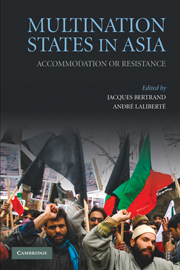Book contents
- Frontmatter
- Contents
- List of Tables and Figures
- List of Maps
- List of Contributors
- Acknowledgments
- Maps
- 1 Introduction
- 2 Revolutionary State Formation and the Unitary Republic of Indonesia
- 3 The Crisis of Border States in India
- 4 Pakistan: Neither State Nor Nation
- 5 Constitutional Politics and Crisis in Sri Lanka
- 6 The Dilemmas of Burma's Multinational Society
- 7 The Double-Edged Sword of Autonomy in Indonesia and the Philippines
- 8 China and the Virtual Taiwan Nation
- 9 The Failure of Ideologies in China's Relations with Tibetans
- 10 Leninism's Long Shadow in Central Asia
- 11 Conclusion
- References
- Index
4 - Pakistan: Neither State Nor Nation
Published online by Cambridge University Press: 05 June 2012
- Frontmatter
- Contents
- List of Tables and Figures
- List of Maps
- List of Contributors
- Acknowledgments
- Maps
- 1 Introduction
- 2 Revolutionary State Formation and the Unitary Republic of Indonesia
- 3 The Crisis of Border States in India
- 4 Pakistan: Neither State Nor Nation
- 5 Constitutional Politics and Crisis in Sri Lanka
- 6 The Dilemmas of Burma's Multinational Society
- 7 The Double-Edged Sword of Autonomy in Indonesia and the Philippines
- 8 China and the Virtual Taiwan Nation
- 9 The Failure of Ideologies in China's Relations with Tibetans
- 10 Leninism's Long Shadow in Central Asia
- 11 Conclusion
- References
- Index
Summary
Pakistan, one of two states that emerged from the breakup of the British Indian Empire, had been created as the putative homeland for the Muslims of South Asia. From its very genesis, the precise social and political dimensions of the state have been contested. If it is the “homeland” of the Muslims of South Asia then what status should it accord to its religious minorities, as well as to sub-state nations? How should it accommodate the demands of linguistic, sectarian, and regional minorities? Beyond the shared Islamic faith, what other attributes could serve as the constituent elements of nation building? And even if Islam constituted the unifying basis of the state, what role would it play in the everyday life and practices of its citizenry? These are questions to which the founders of the Pakistani state had paid scant attention. Yet they came to the fore almost immediately in the wake of Independence and Partition. They have also dogged the existence of the country ever since, and they have been the subject of vigorous and violent contestation (Ahmed, 1997). Sixty years after its creation, Pakistan is no closer to addressing these vital concerns. Instead they pose a continuing challenge to national identity and integration. Specifically, Pakistan still faces important sub-state national movements in Baluchistan, in the North-West Frontier Province (NWFP), and Sindh.
- Type
- Chapter
- Information
- Multination States in AsiaAccommodation or Resistance, pp. 81 - 102Publisher: Cambridge University PressPrint publication year: 2010
- 4
- Cited by

